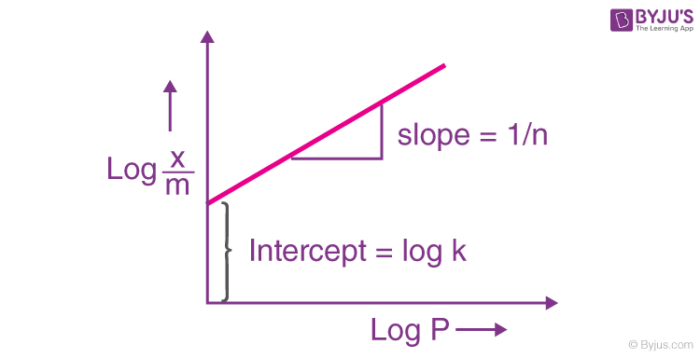What is Adsorption Isotherm?
Adsorption isotherms have been of immense importance to research dealing with environmental protection and adsorption techniques. The two primary methods used for predicting the adsorption capacity of a given material are known as the Freundlich and Langmuir isotherms.
Table of Content
An adsorption isotherm is a graph that represents the variation in the amount of adsorbate(x) adsorbed on the surface of the adsorbent with the change in pressure at a constant temperature.

As we know from Le Chatelier’s principle, the direction of equilibrium in a reaction shifts in the direction in which stress is relieved. So, here we can see that upon application of excess pressure on the system, the equilibrium shifts in the direction where the number of molecules decreases so that the pressure in the system decreases.
From the graph, we also observe that after attaining a pressure Ps, that is the saturation pressure, the variation in the amount of adsorbent adhering to the adsorbate becomes zero. This happens because the surface area available for adsorption is limited and as all the sites are occupied, a further increase in pressure does not cause any difference.
Different adsorption isotherms have been proposed by different scientists namely,
- Langmuir isotherm
- Freundlich isotherm
- BET theory
The graph shown above shows the isotherm proposed by Freundlich.
Recommended Videos

Freundlich Adsorption Isotherm
Freundlich adsorption gives the variation in the quantity of gas adsorbed by a unit mass of solid adsorbent with the change in pressure of the system for a given temperature. The expression for the Freundlich isotherm can be represented by the following equation:
 where n>1
where n>1
Where x is the mass of the gas adsorbed, m is the mass of the adsorbent, P is the pressure and n is a constant which depends upon the nature of the adsorbent and the gas at a given temperature. Taking the logarithm on both the sides of the equation, we get,
![]()
The plot of this equation is a straight line as represented by the following curve.

Langmuir Adsorption Isotherms
The Freundlich adsorption isotherm is followed by another two isotherms, Langmuir adsorption isotherms and BET theory. The Langmuir adsorption isotherms predict linear adsorption at low adsorption densities and a maximum surface coverage at higher solute metal concentrations.
The Langmuir adsorption isotherm has the form:
Where
- θ is the fraction of the surface covered by the adsorbed molecule.
- K is an equilibrium constant known as the adsorption coefficient.
- { K= ka/kd = rate constant for adsorption/ rate constant for desorption}
- p is the pressure.
The Langmuir adsorption is applicable for monolayer adsorption onto a homogeneous surface when no interaction occurs between adsorbed species.
BET Adsorption Isotherm
The theory of multilayer adsorption proposed by Brunauer, Emmett and Teller in 1938 (BET Theory) assumes that physisorption results in the formation of multilayer adsorption. The theory also assumes that the solid surface has uniform sites of adsorption and that adsorption at one site does not affect adsorption at neighbouring sites.
After the formation of the monolayer, the adsorption process can continue with the formation of the multilayer involving the second layer, third layer and so on.
The equation for BET is
Applications of Adsorption
Following are the applications of adsorption:
- Gas masks: Poisonous gases get adsorbed at the surface of the mask and prevent its encounter when used by coal miners.
- Production of vacuum: Traces of air are adsorbed on charcoal and removed from devices undergoing the process of evacuation.
- Removal of moisture: Silica gel pellets are used for the adsorption of moisture in medicines and new plastic bottles in order to control humidity.
- Removal of colour: The juice extracted from cane is treated with animal charcoal for the removal of the colouring agent in order to get a clear liquid solution.
- As Catalysts: Suitable materials are used as a catalyst such that reactants get adhered to its surface, thus enabling the reaction to proceed at a faster rate and increasing the rate of reaction.
Frequently Asked Questions – FAQs
What is the purpose of adsorption?
Adsorption is the adhesion from a gas, liquid or dissolved material to a layer of atoms, ions or molecules. This process creates an adsorbent film on the adsorbent’s surface.
What is the purpose of isotherms?
Isotherm, a line drawn at the same temperature on a map or graph connecting points. Isotherms are commonly used in meteorology to view temperature distribution on the surface of the Earth or on a chart showing steady or constant pressure.
What factors affect adsorption?
Adsorption factors include substratum temperature, pore volume, degree of saturation, type of molecular sieve, type of adsorbent, and unique substratum surface area. At the top end, the width of a football pitch can be the surface area of 1 gm of the molecular sieve.
Does adsorption increase with temperature?
Yes, with increased temperature, the adsorption potential increases. The adsorption ability of an adsorbent increases with temperature because the absorption of dye increases with the increase in temperature because dye molecules can obtain sufficient energy to interact with the active site on the substrate.
What is the principle of adsorption?
Adsorption is also the process of deposition of gas or liquid molecules on a solid surface. “Adsorption” is a well-established and effective technique for domestic and industrial effluent care. The most commonly used process of water treatment is “adsorption” to the activated carbon layer.
To learn more about Adsorption isotherms, the applications of adsorption and other related topics, download BYJU’S The Learning App.


Comments